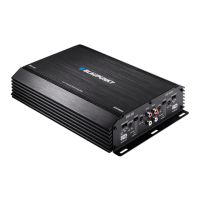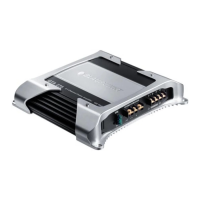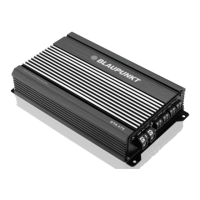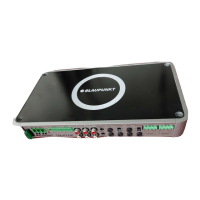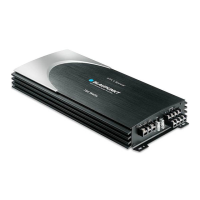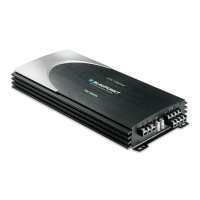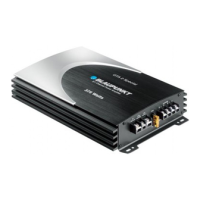6
EMA 260
Stereo Mode
RMS power
2 x 55 Watt / 4 Fig. 4, 5
Mono mode
RMS power
1 x 160 Watt / 4 Fig. 6
Stereo Mode
RMS power
2 x 80 Watt / 2 Fig. 4, 5
RMS power in accordance with CEA-2006
(< 1% dist. / +14.4V)
Frequency
response
10 Hz - 25.000 Hz
Signal-to-noise ratio
> 90 dB @ RMS power
Signal-to-noise ratio
> 73 dB @ 1 W / 1kHz
Distortion factor (RMS)
< 0.05%
Stability
2 (4 in bridge mode)
Input sensitivity
0.3 – 8 V
Low-pass filter
(Low Pass)
50-250 Hz
High-pass filter
(High Pass)
50-250 Hz
Bass boost
0 dB to +12 dB
Dimensions
W x H x D (mm)
W x H x D (")
230 x 56 x 200
9.1 x 2.2 x 7.9
Plus / minus connection
- We recommend a minimum cross section of 6 mm
2
.
- Route commercially available plus cables to the
battery and connect via fuse holder.
- Use cable glands for holes with sharp edges.
- Securely fasten commercially available minus cables
to a noise-free earth point (chassis screw, chassis
metal) (not to the minus pole of the battery).
- Scrap the contact surfaces of the earth point until
they are bright and grease with graphite grease.
Integrated fuses (Fuse)
The fuses integrated in the amplifier (Fuse) protect the
power amplifier and the entire electrical system in case
of an error. If a replacement fuse is used, never bridge
fuses or replace them with a type with higher current.
Connection examples
Connection of the voltage supply Fig. 2
Connection to car sound system with
cinch output Fig. 3
Loudspeaker connections Fig. 4/5/6
Note:
To avoid damaging the amplifier in operation, all loud
-
speaker connections must be occupied according to
Fig. 4, 5, 6.
Remote connection of the amplifier with switchable +12 V
voltage source.
This allows the amplifier to be switched on and off using
the on/off-switch of the radio device.
Level control
The Level control is used to adjust the input sensitivity
of the power amplifier to the output voltage of your car
sound system preamplifier output.
The adjustment range is from 0.3 V to 8 V.
If a car sound system of a third party manufacturer is
connected, the input sensitivity must be adjusted cor
-
responding to the manufacturer data.
A few important explanations in this context:
By turning the control clockwise, the input sensitivity of
the amplifier and, therefore, also the volume increases.
However, this is not a volume control; no further ampli
-
fier output can be achieved in the end position, even if it
may sound like that at the beginning. The system merely
increases the volume faster if the volume control of the
car sound system is turned up.
Loudspeaker connections
(If the amplifier is to be jumpered, continue with the sec
-
tion "Bridged loudspeaker connections" at this point).
As with every audio component, the correct polari
-
sation of amplifier and loudspeakers is of essentially
importance for a good bass response. For this reason,
ensure that the positive (+) connection of the amplifier
is connected with the positive connection (+) of the
loudspeaker; the same applies to the negative (-) con
-
nections. In addition, the left amplifier channel must
be connected with the left loudspeaker and the right
amplifier channel with the right loudspeaker.
Bridged loudspeaker connections
The EMA amplifier can also be bridged for a mono
configuration. This allows the amplifier to be used for
one or several subwoofers or mid-range drivers. In this
configuration, the amplifier combines the right and left
channel to a single-channel output (mono output).
Note:
The amplifier can add the right and left signal informa
-
tion only if the right as well as the left RCA connection
were carried out.
Caution:
In a bridge circuit, the amplifier load must be 4 ohm
or higher. A lower load leads to an overheating or
switch-off of the amplifier and can cause permanent
damages.
Adjusting the type and range of the frequency
crossovers
With the EMA 260, the type of frequency crossover (i.e.
"Low Pass" or "Hi-Pass") and the desired entry frequency
can be adjusted. For example, if a pair of subwoofers is to
EMA_260_181207.indd 6 08.08.2008 11:45:50 Uhr
